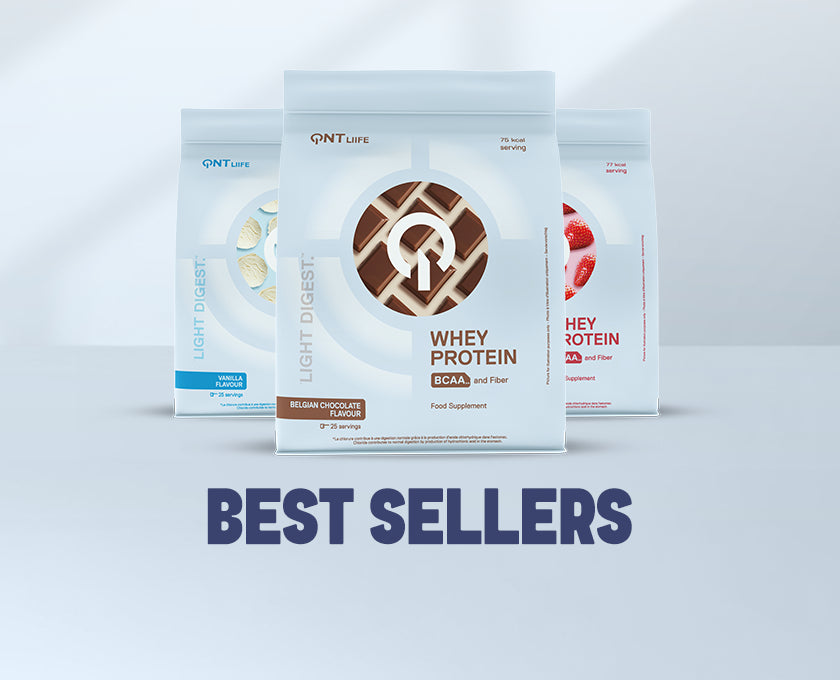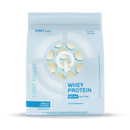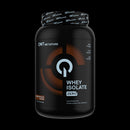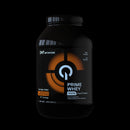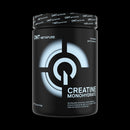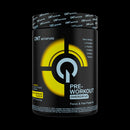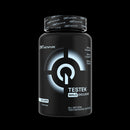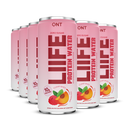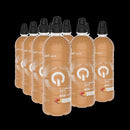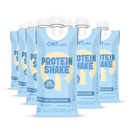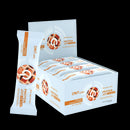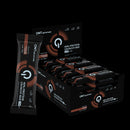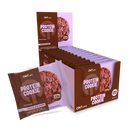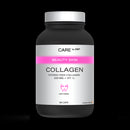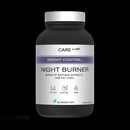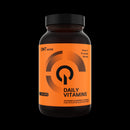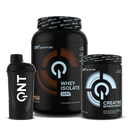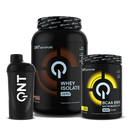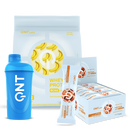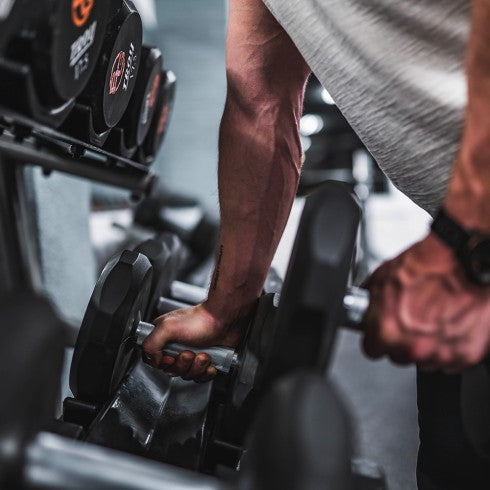Table des matières

Sommaire.
- Comment prendre du muscle sec ?
- Prendre du muscle : concepts de base
- Programme d'entraînement.
- Programme nutritionnel.
- Compléments alimentaires et vitamines nécessaires.
- Idées de plats.
- Erreurs courantes à éviter.
- Conclusion.
Comment prendre du muscle sec ?
La construction musculaire ne peut se concevoir qu’en respectant certains principes : adapte ton alimentation et adapte ton entraînement ! Nous ne sommes pas égaux. Nous allons tous réagir différemment à un entraînement particulier et à un régime particulier. Apprends à connaître tes différences afin de te tromper le moins possible.
Contrôler sa progression !
Vérifie aussi que tu es sur la bonne voie ! Si ton évolution est bonne, c’est que tu as trouvé ce qui te convient ! Si tu ne progresses plus, il est temps de changer tes habitudes . Pour cela n’hésite pas à prendre régulièrement tes mesures : ton poids, tes mensurations au niveau des bras, des jambes et de la poitrine et aussi ton taux de graisse te donneront des indications précises sur ton évolution. Pour bien bâtir du bon muscle , tu devrais aussi compter sur un bon coach qui te mesurera et s’assurera de ta progression. Bien sûr, le coach miracle n’existe pas ! C’est une collaboration à 2 qui t’assurera le succès.
La construction musculaire est un processus parfois long : Une bonne progression en masse musculaire sera d’environ 3 kilos de muscle sec par an. Néanmoins, il est possible que tu prennes un peu plus lorsque tu débutes ou lorsque tu viens de terminer une période de restriction alimentaire en vue de sécher ou lors de circonstances spéciales.
PRENDRE DU POIDS OU CONSTRUIRE DU MUSCLE !
Le but n’est évidemment pas de prendre du poids, mais du muscle. Néanmoins, la plupart du temps, une prise de masse musculaire s’accompagne aussi d’une prise de gras. Si ce n’était pas le cas, les athlètes feraient de la construction musculaire avant une compétition.
Ce que tout le monde voudrait, c’est prendre le moins de gras possible en prenant le plus de muscle possible et ce ne sera réalisable qu’en contrôlant ton avancée et en situant ton apport calorique légèrement au-dessus de ton métabolisme de base.
C’est le nombre de calories dont ton corps a besoin pour assurer ses besoins au cours d’une journée. Comme vous pourrez le constater, une prise de masse sèche n’est pas chose aisée.
Différences selon le morphotype ?
Il y a pourtant certaines règles qui peuvent t’aider. Les différences morphologiques qui te caractérisent peuvent guider aussi ta progression :
Si tu es Endomorphe, tu as tendance à prendre très vite du poids et même de la graisse. Tu dois donc limiter au maximum les écarts et faire très attention à ne pas dépasser ton métabolisme de base de façon incontrôlée.
Si tu es Mésomorphe, tu prends facilement du muscle et pas trop de graisse. Même sans faire de sport, tu parais musclé ( oui, je sais , ce n’est pas juste ) et tu pourras monter un peu plus haut en calories dans ton processus de construction musculaire qui restera efficace la plupart du temps.
Si tu es Ectomorphe, tu restes mince, voire maigre, quoi que tu fasses et tu prends du poids plus difficilement quoi que tu manges . Même les écarts ne t’aideront que substantiellement . Tu peux donc monter très haut en calories sans avoir peur de voir ton ventre se couvrir d’une couche de graisse. Attention quand même, en prenant de l’âge, tu restes mince, mais tu risques de prendre du ventre si tu ne fais pas trop attention.
MA MORPHOLOGIE EST-ELLE LE SEUL FACTEUR POUR UNE PRISE DE MUSCLE ?
C’est sûr que si chaque individu pouvait se retrouver à coup sûr dans une catégorie morphologique, on pourrait croire que cela simplifierait la progression. Hélas, la plupart d’entre nous sommes tributaires de 2 catégories morphologiques. Il est très rare de voir un mésomorphe ou un ectomorphe parfait.
Souvent un individu sera plus mésomorphe qu’endomorphe mais aura aussi certaines caractéristiques de cette catégorie morphologique.
Il est donc illusoire de penser que ta prise de masse musculaire sera un parcours de santé. Ce sera plutôt le parcours du combattant !
Tu devras faire attention à ta diète, qui chaque année pourra changer car ton corps va aussi changer. Tu devras faire attention à ton entraînement et regarder ce qui te profite le plus, mais aussi le modifier régulièrement et tu devras aussi adapter tes suppléments diététiques à ta progression.
Si tu le fais sérieusement, tu vas apprendre quelque chose qui va te servir toute ta vie : le pouvoir de se remettre en question ! Regarde combien de vies a vécu un champion comme Arnold ! Sport, cinéma, politique, re-cinéma, il a tout réussi . Chacune de ses carrières est le résultat d’une remise en question. Et c’est dans son sport qu’il a acquis cette qualité ! La prise de masse sèche, le contrôle de son corps, lui, il connaît !
EVITE LES “MIRACLES" DES RÉSEAUX SOCIAUX !
Tu trouveras facilement sur les réseaux des faiseurs de miracles : ils pourront te faire une prise de masse sèche rien qu’en claquant des doigts ! Les miracles n’existent pas !
Certains posteront même toute l’année des photos de leur physique sec alors qu’il n’auront été secs qu’un mois sur l’année. Mais pour leur image, ils posteront toute l’année des photos de leur corps en pleine forme.
Cela leur permettra de dire à leur fans qu’ils sont les meilleurs athlètes, les meilleurs coachs, alors que tout cela n’est que de la poudre aux yeux.
Ce sont souvent à cause de telles pratiques que le concept de prise de masse sèche est autant galvaudé et que les gens pensent qu’il est tellement facile de prendre 10 kilos de muscle sec.
Le bodybuilding, la musculation, le power training sont synonymes mais si tu veux un résultat visible, tu dois absolument ajouter la nutrition à ton entraînement. Si tu ne le fais pas, tu ne pourras pas prendre de muscle sec, et peut-être pas de muscle du tout ?
Mais si tu vois que tes poids progressent, que ton entrainement est de plus en plus intense, même si ton volume musculaire ne change pas, tu es en route vers une progression, à toi de l’adapter en l’affinant et en tentant de prendre du muscle sec.
Nous allons tenter de t’aider au mieux.
CONSTRUIRE DU MUSCLE : CONCEPTS DE BASE.
CONSTRUIRE DU MUSCLE OU PRENDRE DE LA MASSE ?
Construire du muscle, c’est prendre du muscle avec un objectif de performance dans un sport particulier. Prendre de la masse musculaire, c’est surtout dans un but esthétique. Il y a donc deux approches assez différentes sur le sujet et bien sûr deux mesures différentes. Mesurer ta prise de masse musculaire se fera avec prise du poids, mensurations des segments et taux de graisse. Pour mesurer la construction musculaire, tu devras aussi mesurer les performances dans le sport où tu performes. Sinon, comment distinguer une prise de masse sèche et une prise de masse grasse ?
N’oublie pas que les qualités musculaires sont multiples : force, endurance, résistance, souplesse, explosivité ou vitesse et coordination.
Prendre de la masse musculaire peut ainsi diminuer ta souplesse si tu ne la travailles pas. Ne pas travailler sa souplesse et travailler son explosivité peut occasionner des blessures de type claquage, élongation ou déchirure. Il est donc important d’inclure un travail de construction musculaire dans un programme plus large au service des performances. Néanmoins, le résultat visuel sera aussi moins important que dans une prise de masse.
Ces considérations seront aussi à prendre en compte pour prendre de la masse musculaire, néanmoins, la performance n’est pas la motivation principale. Le visuel est le moteur principal.
QUEL EST LE BON MOMENT POUR PRENDRE DU MUSCLE ?
Tout dépend toujours de ton objectif : Si tu es compétiteur dans une discipline sportive, ce sera surtout l’agenda des compétitions qui t’imposera quand te reposer et quand tu pourras mettre les bouchées doubles et prendre du muscle. Si tu n’es pas compétiteur, tu pourras adapter ta prises de muscle à tes objectifs personnels et profiter peut-être, comme beaucoup, des vacances pour montrer ta meilleure silhouette sur les plages.
Sache cependant que ton apport calorique sera différent selon la période de l’année : En hiver, tu auras besoin de plus de calories qu’en été. Ce qui est tout à fait logique : la température de ton corps est de 36,5 degrés en moyenne et il va devoir réagir à la différence de température par rapport au milieu extérieur. S’il fait 30 degrés en été, il va devoir réchauffer ta température corporelle de 6 degrés. En hiver par contre, s’il fait 0 degrés, il va devoir faire un effort plus important pour passer de 0 à 36 degrés.
Ton âge aussi va influer sur ta prise de muscle. Il est plus facile de prendre 3 kilos de muscles à 20 ans qu’ à 60. Il faudra donc parfois trouver une autre motivation que la performance lorsque tu avanceras en âge. Par exemple, rester en bonne santé et limiter les dégâts du temps qui passe en gardant une bonne masse musculaire. Car prendre du poids, même musculaire peut, à partir d’un certain âge, occasionner des problèmes tendineux ou articulaires.
MUSCULATION ET NUTRITION ADAPTÉE.
LES NUTRIMENTS.
Les protéines.
Lorsque tu t’engages dans un processus de construction musculaire, tu dois adapter ton alimentation à ton objectif ! Il semble tout à fait logique que prendre de la masse musculaire te fasse prendre un peu de poids donc tu devras augmenter ton apport nutritionnel. Les aliments sont divisés en plusieurs catégories : Les protéines, les glucides et les lipides. La base de la construction musculaire, ce sont les protéines. Un apport considéré comme normal à l’heure actuelle des connaissances est entre 0.83 et 2.2 grammes par kilos de poids de corps par jour. 0.83 pour une personne sédentaire et 2.2 gr pour un sportif. Pour les bodybuilders, cela peut monter à 3 gr/ kilo de poids de corps.
La première chose à faire est de faire un constat : combien de protéines par jour consommes-tu ? Une fois que tu le sais, augmente ton apport journalier de façon significative et tu viendras de franchir le premier pas de ton chemin pour une alimentation constructive.
Les glucides.
La deuxième catégorie d’aliments, ce sont les glucides. Si on pouvait comparer la construction de ton corps avec celle d’une maison, on pourrait dire que les protéines sont les briques qui constituent le mur et les glucides l’énergie que les maçons mettent dans la construction de la maison. Donc tu as besoin d’énergie ! Et cette énergie sera fournie par les glucides. Attention ! La qualité des glucides est très importantes ! Il existe des glucides ou des sucres rapides et des lents ! Les sucres rapides arrivent très vite dans le sang et provoquent donc une réponse insulinique importante, ce qui entraîne à l’occasion une baisse de sucre dans le sang et parfois de la fatigue. Les sucres lents quant à eux diffusent plus lentement les glucides dans le sang et procurent donc des quantités limitées et étalées dans le temps qui permettent à ton corps de disposer de plus d’énergie plus longtemps.
Tu pourras par contre manger des sucres rapides juste après l’entrainement car ton corps est en demande, il va absorber directement les sucres présents dans le sang. De même, les athlètes d’endurance auront besoin régulièrement d’absorber des sucres rapides pour ne pas subir l’effet du “coup de pompe”.
Comme pour les protéines, tu devras augmenter progressivement ton apport glucidique en veillant à ne pas arriver en excès calorique.
Les lipides.
Enfin, viennent les lipides, autrement dit les graisses. Ton corps en a besoin ! Pour les membranes de cellules, certaines hormones, la signalisation cellulaire, la composition de certaines vitamines, mais surtout, les lipides sont une réserve d’énergie. En gros, lorsque tu procures trop de calories à ton corps, il n’élimine pas le superflu, il le garde en réserve dans des cellules graisseuses qu’on appelle des adipocytes. Le problème de ces cellules, c’est que lorsqu’elles sont pleines, elles se multiplient pour faire face à la demande, mais que lorsque tu réduis ton apport calorique par après,, elles se vident mais ne disparaissent pas. Il est donc plus difficile de revenir en arrière lorsque tu auras fait une mauvaise prise de poids. D’où l’importance de contrôler ton alimentation.
En ce qui concerne les lipides, le seul apport intéressant sera sous forme de vitamines liposolubles, à moins que tu sois ectomorphe.
LA FRÉQUENCE DES REPAS.
Il est toujours conseillé de manger en plusieurs petites quantités plutôt qu’en un seul apport calorique par jour. Préfère toujours 5 ou 6 repas par jour avec un apport calorique équilibré, plutôt qu’un déséquilibre calorique journalier. En effet, si tu amènes souvent des aliments à ton corps, il va réagir naturellement : il fera moins de réserves car il sait que toutes les 3 heures, il recevra de quoi bien alimenter toutes ses fonctions vitales.
Si par contre tu ne lui donnes à manger qu’une fois ou deux par jour, il aura tendance à réagir en pensant qu’il doit faire des réserves par sécurité et surtout, il risque d’éliminer ce qui coûte de l’énergie et qui n’est pas indispensable au bon fonctionnement du corps humain : le muscle.Il est donc important de faire réagir ton corps de la bonne manière en lui procurant tous ses besoins essentiels en temps et en heure. Veille donc à ne pas sauter de repas mais à respecter ton plan alimentaire.
L’IMPORTANCE DE L’EAU.
Notre corps est composé à plus de 60 % d’eau. C’est donc important de l’hydrater. Surtout si tu augmentes ton apport protéique. En effet, l’exercice musculaire a pour effet, non pas de construire du muscle mais de le détruire ! Et en réaction à cette destruction, ton corps va utiliser les nouvelles protéines que tu vas lui procurer pour reconstruire le muscle dégradé plus fort, afin de ne pas subir une deuxième fois une situation aussi inconfortable pour lui. La progression musculaire est donc une réaction à un entrainement inconfortable pour le muscle ou la chaîne musculaire.
Mais si il y a élimination de protéines, ce sera le travail des reins. Il faudra donc du liquide pour éliminer ces dégradations musculaires. Un sportif devrait boire entre 2 à 3 litres par jour, selon son poids et son activité. Une grande partie pendant le sport qu’il pratique. Une bonne façon de voir si tu bois assez est de regarder la couleur de ton urine. Si elle est jaune, tu ne bois pas assez, si elle est quasi blanche, tu es suffisamment hydraté.
LES COMPLÉMENTS ALIMENTAIRES.
Manger toutes les 3 heures suppose une logistique adaptée et pas toujours facile à mettre en place. Pour ne pas trop galérer, tu dois t’organiser et utiliser des suppléments qui te faciliteront la vie. Faire à manger une ou deux fois par semaine est une manière de simplifier son organisation. Si tu dois préparer à manger toutes les 3 heures, tu risques de passer ton temps en cuisine. Les suppléments alimentaires peuvent, eux, te faciliter la vie ou booster ton programme et tes objectifs : les vitamines et minéraux, les protéines en poudre, Whey ou caséine, les gainers, la créatine, les bcaa, la glutamine, les boosters hormonaux, les pré- workout, les omégas 3 sont tous des éléments qui peuvent t’aider dans tes objectifs. Un shake protéiné peut t’éviter de faire à manger et si tu comptes combien te coûte un repas équilibré, tu verras que ce shake te feras économiser de l’argent.
NOS CONSEILS.
Tu peux le constater, construire du bon muscle n’est pas chose simple. Même s’il y a des principes de base, il n’est pas exclu que tu sois une exception. La meilleure chose à faire est donc d’apprendre à te connaître, à observer comment ton corps réagit. Fais-toi aider au départ et n’oublie pas de tenir un roadbook dans lequel tu noteras tes résultats, tes entraînements et ta diète. N’oublie pas que nous sommes là pour t’aider !
Beaucoup d’idées préconçues courent aussi dans les conversations entre athlètes. Une bonne prise de masse sèche se situe aux alentours de 3 kilos par an. Je parle ici de 3 kilos SECS, bien sûr. Cela risque peut-être d’en décourager certains qui croyaient pouvoir monter sur scène après 3 mois de salle, mais si vous comptez bien, 3 kilos par an, cela fait 30 kilos en 10 ans. Une prise de masse sèche de 30 kilos en 10 ans grâce à la musculation et à l’alimentation, c’est quand même un bon résultat ! Si tu pèses 70 kilos, au départ, tu arrives à 100 kilos après 10 ans de musculation !
Evidemment, ces chiffres sont une moyenne approximative. Chacun est différent et chacun évolue différemment en musculation.
Par contre, si vous êtes débutants, vous pouvez prendre beaucoup plus les premières années.
PROGRAMME D’ENTRAÎNEMENT.
Il n’y a pas UNE méthode d'entraînement, mais il est important de varier les entraînements et les exercices. Par contre, pour pouvoir contrôler sa progression, il est important de bien noter tout ce que tu réalises comme performance à l’entraînement. Lorsque tu dois te rendre quelque part, si tu ne connais pas l’endroit où tu te trouves, il est difficile d’entamer un trajet. Vérifie où tu en es et ce que tu fais. De nouveau, il faudra distinguer aussi l’objectif que tu t’es fixé, prendre de la qualité musculaire pour un sport particulier ou prendre de la masse musculaire.
PRINCIPES POUR L'ENTRAÎNEMENT DE LA MASSE MUSCULAIRE.
Il est de notoriété publique que l'entraînement de masse musculaire se réalise avec des exercices pluri articulaires et en réalisant des séries de 10 à 12 répétitions. Le nombre de séries le mieux adapté dépend un peu de la région musculaire travaillée. Pour les gros muscles, comme les jambes, on peut réaliser des séances de 16 à 20 séries effectives. Pour les intermédiaires , comme le dos et les pectoraux, de 12 à 16 séries et pour les bras, de 10 à 12 séries. Bien sûr chacun devra adapter son nombre de séries en fonction des résultats obtenus. Il se peut que ton entraînement ne convienne pas à un autre athlète et vice-versa.
Néanmoins, il est important de réaliser chacune de tes séries à l’échec ! C’est à dire jusqu’au moment où tu ne pourras plus lever le poids. Si tu arrives à lever le poids plus de 12 fois, augmente d’office celui-ci pour la série suivante. A l’inverse, si tu ne parviens pas à lever plus de 9 fois les poids choisis, diminue pour la série suivante. En augmentant et diminuant tes poids de cette manière, tu pourras habituer ton corps à la surcharge musculaire nécessaire à une bonne progression.
PRINCIPES POUR L'ENTRAÎNEMENT DE LA QUALITÉ MUSCULAIRE.
Dans ce cas de figure, on sera plus axé sur la performance que sur la masse pure. Mais performance dans un sport ne veut pas dire uniquement volume musculaire, d’autres facteurs importants entrent en ligne de compte : la souplesse, l’influx nerveux nécessaire à une contraction explosive, la force pure...
Il est donc plus difficile de donner un principe de base pour un entraînement sans en connaître la finalité ou la spécificité.
Principes de base pour s’entraîner.
Par contre, certains principes sont communs à toute personne qui veut évoluer dans un domaine :
- Se donner à fond ! Ne pas économiser ses forces pour l’exercice suivant ou la fin de l'entraînement. Si tu ne parviens plus à bouger en fin d'entraînement, ce ne sera que la preuve que tu as fait ton maximum et tes performances ne risquent que d’évoluer
- Entraine tes muscles une fois par semaine. Chaque muscle a une période de récupération optimale qui lui est propre. Les petits muscles comme les biceps peuvent avoir complètement récupéré après 2 jours tandis que les cuisses nécessitent 5 jours. Ce qui voudrait dire que pour avoir un résultat optimal, il faudrait entraîner ses bras tous les 2 jours, ses pectoraux et son dos tous les 4 jours et ses cuisses tous les 5 jours. Cela mènerait à des jours où tu devrais tout entrainer et des jours où il n’y aurait rien à faire. En théorie, c’est possible. En pratique, le corps serait trop épuisé pour vraiment avoir une progression maximale. Donc, entraîner chacun de ses muscles une fois par semaine semble un bon compromis pour bien évoluer.
- Ne pas oublier les étirements ! Sans cela, tu risques plus facilement des blessures. Et qui dit “blessure”, dit aussi arrêt d’entrainement et donc arrêt de la progression que tu espérais tant.
- N’aie pas peur de la stagnation même si tu te donnes à fond ! Ton corps a besoin de périodes de stagnation où il doit intégrer tes progrès dans son nouveau schéma corporel. Tu progresseras rarement selon un schéma linéaire, mais plutôt selon un schéma en forme d’escalier.
- Ne t’entraîne pas si tu es malade ! Ton corps va déjà utiliser une grosse partie de son énergie pour combattre la maladie. Si après un entrainement, tu peux avoir la sensation de te sentir mieux, il y a de grandes chances que le lendemain ce soit pire.
COMMENT AUGMENTER LA DIFFICULTÉ OU L’INTENSITÉ DE MON ENTRAINEMENT ?
Augmenter l’intensité n’est pas uniquement augmenter les poids ou le nombre de répétitions. Tu as plusieurs manières d’augmenter l’intensité de ton entraînement :
- Le poids ou la charge de l’exercice, bien sûr.
- Le nombre de répétitions avec la même charge.
- Tu peux diminuer tes temps de repos et par là-même diminuer la durée de la séance tout en gardant le même contenu ou en l’augmentant.
- Tu peux améliorer la qualité du mouvement. Ce qui veut dire rester strict dans l’exécution d’un exercice et ne pas tricher en lançant le poids avec une autre partie du corps.
IMPORTANCE DU REPOS ET SURENTRAÎNEMENT.
Le repos et le surentraînement sont souvent liés. Le trop est l’ennemi du bien, dit-on souvent. Si tu veux voyager loin , il faut ménager sa monture. Pourtant beaucoup de sportifs pensent que plus ils en font, plus ils progresseront. C’est totalement faux. Ce qui va faire progresser un sportif, c’est l’équilibre entre des séances intensives et des jours de repos. Mais de nouveau, il faut pouvoir faire une distinction selon les objectifs et selon les sports. Un marathonien aura beaucoup de séances longues et l’athlète de force, moins de séances, plus courtes et plus intenses.
Alors, comment savoir si on en fait trop ? Écoute ton corps : si tu es anormalement fatigué, si tu fais des blessures à répétitions, si tu as un ras-le-bol de l'entraînement, tu en as demandé trop à ton organisme, tu es peut-être proche d’un surentraînement. Il est temps de se poser, de prendre le temps qu’il faut pour retrouver la joie de l'entraînement et surtout l’efficacité d’un bon programme.
En général, pour un entraînement en musculation, 2 jours de repos par semaine semblent être un bon compromis si tu imposes à ton corps des séances très dures. Mais bien sûr, un cas n’est pas l’autre.
QUELQUES ENTRAÎNEMENTS (LISTE NON EXHAUSTIVE ).
- Le 10 à 12 répétitions ; comme cité plus haut, c’est le classique pour construire de la masse musculaire.
- Le heavy-duty : développé par Mike Mentzer. Il consiste à peu de séries mais à très haute intensité et surtout très lourd.
- Entraînement 3 jours par semaine 2 jours de repos entre les entraînements.
- 7 à 9 séries par entraînement
- Exemple : 3x12 et 4x8
- Le MAX-OT ou maximum overload training :
- 2 muscles par entraînement
- 4 à 6 répétitions par série
- 6 à 9 séries par muscle
- Repos de 2 à 3 minutes entre chaque série
- 30 à 40 minutes d'entraînement par séance maximum et 2 jours de repos par semaine
- Prendre une semaine de repos régulièrement pour ne pas tomber dans le surentraînement
- Le FST-7 ou Fascia Stretch training. Le principe est de terminer chaque séance d'entraînement pour chaque muscle par 7 séries d’isolation entrecoupées de 30 à 40 secondes de repos pour étirer la membrane qui entoure le muscle et favoriser son développement. Il faut aussi étirer ses muscles avant, pendant et après l'entraînement.
- 6 séries de 8 à 12 répétitions avec un exercice pluri-articulaire pour les petits muscles et 11 à 12 séries pour les plus gros.
- Juste après 7 séries de 8 à 12 répétitions avec un exercice d’isolement entrecoupées de repos de 30 à 40 secondes.
- Le SST ou Sarcoplasm stimulating training est un travail en circuit jusqu’à l’épuisement.
Variété dans l'entraînement. En voici 2 exemples
- 1er exemple avancé : Circuit 1 : 1 série de 8 répétitions avec un poids adapté, puis 10 secondes de repos, une série de 5 répétitions avec le même poids, 10 secondes de repos et une série de 1 répétition avec toujours le même poids Circuit 2 dans la même séance : enlever 20 % du poids précédent et réaliser Le même parcours sauf pour la deuxième série où on ne fera que 3 répétitions.
- 2ème exemple ; 1 série de 6 répétitions avec un poids adapté, 15 secondes de repos, une série de 4 répétitions avec le même poids, puis 15 secondes de repos, on diminue la charge et on réalise une série de 5 répétitions en excentrique en 5 temps ( lent), on diminue de nouveau la charge, on prend 15 secondes de repos et on réalise une série de 5 répétitions en concentrique en 5 temps, on se repose 15 secondes et on réalise une série en isométrique de 45 secondes. Après cela on prend 2 exercices pour le même muscle et on combine en série de 10 à 12 répétitions.
L'entraînement est très court mais très intense.
La liste n’est pas exhaustive mais te donnera peut-être des idées pour ta prochaine séance. Le but ici n’est pas de donner le “meilleur” entraînement, car chacun risque d’avoir différentes sensations qui lui sont propres quand il les testera. Nous sommes tous différents et donc susceptibles de ne pas réagir de la même manière à chaque stimulus engendré par un entraînement particulier. Par contre, rien ne t’empêche de tester et de regarder le résultat, les sensations et le plaisir qu’ils peuvent procurer. Néanmoins ne perds pas de vue que chaque entrainement est intense et te demandera de t’échauffer au préalable. Il faudra aussi t’étirer mais surtout rester attentif à ne pas en faire ni trop ni trop peu.
N’oublie jamais de t’échauffer avant de faire subir à ton corps un entraînement de cette intensité, sous peine de lui infliger des blessures qui ralentiront ta progression.
La plupart des athlètes ont un jour eu une baisse de motivation. Si c’est ton cas, va chercher un de ces entraînements dans un livre ou une revue ou sur internet. C’est peut-être ce qui va rebooster ta motivation et ta progression.
Par contre, l’entraînement “miracle” n’existe pas. De plus, un entraînement que tu as bien senti et qui t’a fait beaucoup progresser cette année peut très bien ne plus avoir le même effet dans un an. N’hésite pas à innover, à chercher, à tester.
PROGRAMME NUTRITIONNEL.
Lorsque tu décides de te mettre au sport, il est important de contrôler ton alimentation pour être performant et efficace, mais il faut aussi savoir que tu auras des besoins différents d’une personne sédentaire . Tu consommeras plus de métabolites, de vitamines, de minéraux...
La qualité des aliments change aussi constamment dans notre société et s’appauvrit de décennie en décennie. Avant de te parler compléments alimentaires, je voudrais te donner des informations importantes sur la nutrition sportive.
LE NOMBRE DE CALORIES NÉCESSAIRE.
Ce qui est bon pour toi n’est pas spécialement bon pour ton voisin. Si tu construis de la masse musculaire avec peu de calories c’est quelque chose qui est particulier à ta personne et qui ne sera pas une vérité pour tout le monde. En fait , il y a des règles de base en nutrition, qui seront valables pour une majorité d’individus, mais il y aura aussi énormément d’exceptions aussi différentes les unes des autres.
Déjà, comme cité plus haut, ton morphotype va déterminer une grosse partie de tes réactions face à la nourriture. Si tu es Ectomorphe, tu auras besoin d’apports caloriques conséquents pour espérer changer ta morphologie, et il se peut que ce soit lent. A l’inverse, un endomorphe peut très vite prendre de la mauvaise masse. Ton métier et ton niveau d’activité physique vont aussi influencer ton apport calorique. Ta nervosité, ton stress sont aussi des facteurs influents tout autant que le type d’activité sportive.
En général, si tu connais ton métabolisme de base, tu dois juste te situer au-dessus. Commence par rajouter une centaine de calories et vérifie si tu ne prends pas trop de graisse. Si c’est le cas, monte encore de 100 ou 200 calories. Si tu prends plus de graisse que de muscle, alors, tu es peut-être monté un peu trop haut...
Par contre, si tu ne connais pas ton métabolisme de base, alors essaye de le trouver. C’est le nombre de calories dont tu as besoin par jour pour assurer tous tes besoins énergétiques. En gros, tu regardes ton progrès.. Lorsque tu stagneras, tu auras atteint approximativement ton métabolisme basal. Ce qui est sûr, c’est qu’on ne peut pas tout contrôler. On va donc essayer de contrôler le maximum en sachant que certains facteurs peuvent nous échapper. Tu vas devoir jouer avec un peu d’approximation.
QUELS ALIMENTS CONSOMMER ?
Ton corps a besoin de plusieurs types d’aliments.
- Les glucides sont appelés aussi sucres ou hydrates de carbone. Ils constituent en majorité “l’énergie” dont le corps a besoin. Ils interviennent aussi dans d’autres domaines tels que l’ADN ou la constitution des membranes cellulaires. Ils influencent le phénomène de satiété et le sommeil. D’ailleurs, tu pourras constater que si tu prends un repas riche en glucides, tu auras très vite tendance à t’assoupir après.
- Les lipides ou graisses jouent eux aussi un rôle important car ils stockent l’énergie dont le corps n’a pas besoin directement. Ils sont aussi très importants pour la constitution des membranes cellulaires, le transport des vitamines liposolubles et la production d’hormones.
- Les protéines composent le muscle, mais aussi les enzymes de notre corps, elles assurent un rôle au niveau du squelette, des tissus, de l’ADN, dans la transmission énergétique ou encore dans la transmission de signaux cellulaires.
Tu l’as bien compris, chacun des différents métabolites a son rôle à jouer. Et si certains gourous te poussent à éviter l’un ou l’autre aliment, sache que ce n’est pas naturel et que ton corps va toujours réagir. Il est donc toujours important de garder un certain équilibre entre ces aliments, mais cet équilibre va changer en fonction de ton objectif, de ta morphologie et d’autres facteurs aussi.
EXEMPLES DE RÉACTIONS.
- Imagine que tu supprimes tous les sucres. Ce qui peut arriver dans certains sports de compétition. Sache dès lors que ton cerveau a besoin impérativement de sucres pour fonctionner. Il va donc transformer tes protéines en sucres et pour cela produire des corps cétoniques. Ce qui veut dire que ton apport en protéines sera utilisé à cette fin, ou alors, il peut aussi dégrader tes muscles pour pouvoir en utiliser ses protéines. Ce processus peut aussi se mettre en route si ton corps a besoin d’énergie, là aussi, il transformera les protéines en glucides.
- Il est très rare et difficile de supprimer les protéines et si c’était le cas, cela engendrerait rapidement des carences et des dysfonctionnements importants et graves. Par contre, les protéines animales sont plus facilement absorbées par le corps humain. Donc, si tu es végétarien, végétalien ou vegan, il faudra faire attention à bien équilibrer ton alimentation par un apport de protéines végétales. La spiruline, par exemple, est un des végétaux qui fournit le plus de protéines, mais aussi le soja, les fèves, les graines...
- Si tu supprimes les lipides, sache que chaque aliment est composé de protéines, d’hydrates de carbone et de lipides. Il y en a moins dans certains aliments que dans d’autres, mais il y en a quasiment toujours un peu. La question que l’on peut se poser est :”Est-ce suffisant ?” Si tu veux être certain de consommer le moins de graisse possible et avoir quand même la quantité nécessaire à ton corps pour bien fonctionner, alors tu auras besoin d’un supplément sous forme de gélules. Par contre, si tu supprimes les graisses et que tu consommes un excès de calories sous forme de glucides ou de protéines, tu auras un trop plein d’énergie que ton corps stockera de toute façon sous forme de graisse. Donc, rien ne sert de tout supprimer non plus, mais il est important de respecter un équilibre entre les protéines, les glucides, les lipides ET les calories.
FAIS ATTENTION !
- Lorsque tu prends trop de masse graisseuse, tes cellules graisseuses vont se remplir. Mais une fois qu’elles sont pleines, ton corps va devoir stocker la graisse ailleurs. Pour cela, il va multiplier les cellules graisseuses. Par contre, une fois que tu auras multiplié le nombre de cellules, pas question de faire le chemin inverse lorsque tu perdras de la masse grasse. Le nombre de cellules ( et donc ta capacité à stocker des lipides ) ne changera pas.
- Prendre des sucres rapides n’est pas spécialement bon : pour le diabète, pour le stockage de graisses qu’il peut vite entraîner. Par contre, le sucre appelle le sucre. Il est parfois plus facile de faire un régime sans sucres rapides que de s’octroyer une petite récompense sucrée qui risque de t’amener à sauter sur tout le sucre qu’il te reste dans l’armoire. Si tu manges suffisamment de sucres lents, ce phénomène a moins de chance de te surprendre. Ton corps sera moins en demande de sucre. Tu peux aussi te faire aider avec un supplément en chrome qui diminue les envies de sucre.
- Lorsque tu augmentes ta consommation de protéines pour une prise de masse musculaire, reste attentif à ne pas oublier de t’hydrater. Tu peux monter jusqu’à 3 l d’eau par jour, selon ton poids corporel, bien sûr.
QUELQUES CONSEILS !
Chacun a un besoin qui lui est propre en calories. La première chose quand tu démarres vers un objectif, c’est de savoir où tu te trouves. Ici , c’est la même chose : si tu as un objectif, mais que tu ne sais pas où tu es tu ne pourras pas connaître la route à emprunter pour t’y rendre. Vérifie comment se trouve ton corps, mesure-le, regarde ton taux de gras. Entame ton entraînement et ta diète et vérifie régulièrement si tu es sur la bonne route . N’hésite pas à te remettre en question !
N’aie pas peur non plus de prendre un peu de gras lorsque tu fais une prise de masse. Tu ne peux éviter une légère prise de gras lorsque tu veux augmenter ta masse musculaire. La prise de masse sèche est un concept difficile à atteindre, naturellement et pour la plupart des individus.
Évite par contre l’exagération et essaye de prendre plus de muscle que de gras. Tout le gras que tu auras pris, il faudra de toute façon le faire partir si tu veux améliorer l’esthétique de ton corps. Un bon équilibre entre ton entraînement en musculation, ton cardio et ton alimentation est la clef de ton succès.
La plupart du temps, les athlètes qui veulent progresser en volume musculaire et pour qui prendre de la masse sèche est quelque chose d’ important alternent les périodes de masse et les périodes de sèche. Pour pouvoir réaliser si on a bien pris de la masse sèche, il suffit alors de comparer ses mensurations à un moment donné avec le même taux de graisse. Si tu vois que tu as plus de volume et plus de poids pour un même taux de gras, tu connaîtras l’évolution exacte de ton progrès.
COMPLÉMENTS ALIMENTAIRES ET VITAMINES NÉCESSAIRES.
La plupart des aliments dans notre alimentation sont transformés. La manière de les cultiver ainsi que l’appauvrissement des terres et bien d’autres facteurs, font que leur valeur nutritive n’est plus la même qu’il y a 60 ans. Les compléments alimentaires peuvent t’aider à compenser les lacunes engendrées par ce problème. Ils peuvent aussi te permettre de gagner du temps en te facilitant la vie.
Lors d’une prise de volume ou de masse musculaire, voici ceux qui paraissent le mieux adapté :
LES VITAMINES ET MINÉRAUX.
Il est très important de prendre un supplément de vitamines et de minéraux lorsque tu veux améliorer ta qualité ou ta masse musculaire. Peu importe l’objectif que tu te fixes, pour être efficace, tu devras adapter ton alimentation. Par contre, il est parfois indiqué de supprimer certains types d’aliments pour un objectif précis. Mais parfois, dans ces aliments supprimés se trouvent aussi des éléments parfois indispensables. Pour pouvoir faire une prise de masse, c’est quelque chose d’important.
D’autre part, un sportif aura aussi besoin de plus de métabolites. Il pousse son corps à utiliser plus d’énergie, à faire plus de réactions chimiques. Donc il va avoir besoin de plus de carburant mais aussi de plus de transporteurs, de plus de catalyseurs, bref de plus d’éléments qui caractérisent les réactions biochimiques propres au corps humain.
Les suppléments en vitamines et minéraux sont donc un élément essentiel pour le bon fonctionnement de ton corps de sportif ! Imagine que tu prennes tout ce qu’il faut pour progresser , mais il te manquerait un seul transporteur et donc pas moyen d’amener le carburant dans la cellule ! Donc, assure-toi bien d’avoir tout ce qu’il faut pour que ton corps ne manque de rien.
- La vitamine C : en hiver, ton corps doit réagir au froid et aux attaques virales ou microbiennes. Si tu prends un petit supplément en vitamine C, il t’aidera sûrement à combattre mieux le rhume et la grippe.
N’aie pas peur de prendre trop de vitamines, si tu en prends de trop, tu les élimineras par voie naturelle. Par contre, en ce qui concerne les vitamines liposolubles, ne dépasse pas l’apport journalier recommandé car tu ne les élimineras pas.
LES PROTÉINES.
Comme nous l’avons vu, les protéines sont un des composants essentiels du muscle. Il est donc impératif d’avoir un apport correctement dosé de protéines en fonction de son objectif. On peut augmenter son apport protéique jusqu’à 3 g par kg de poids de corps, mais alors il te faudra boire aussi beaucoup plus.
N’hésite pas à boire jusqu’à 3 l d’eau par jour, ce ne sera pas de trop
Les différentes protéines en poudre.
Les protéines sont présentes sur le marché sous différentes formes. Alors tu te poses la question : quel type de protéine dois-je consommer pour être le plus efficace possible ?
- La Whey protéine. C’est une protéine rapide. Elle est fabriquée à la base avec du petit lait, le lactosérum. Elle est aussi bien utilisée pour une prise de masse musculaire que pour une perte de graisse car elle doit être incluse dans une diète adaptée.. C’est une protéine qui s’assimile assez rapidement, donc elle est indiquée pour une prise le matin ou directement après l'entraînement.
- La caséine est une protéine de lait. Elle a une assimilation plutôt lente. Tu peux donc la prendre n’importe quand dans la journée ou le soir avant de dormir, si ta diète le demande.
- L’isolate de whey protéine C’est une protéine à l’assimilation très rapide. Fabriquée à base de whey protéine, micro filtrée, elle présente le gros avantage de contenir extrêmement peu de glucides, de lipides mais aussi de lactose. Si tu développes une allergie au lactose, c’est donc celle qu’il te faut.
- Les protéines vegan sont fabriquées à base de pois ou d'autres légumes. Si tu es vegan, une prise de masse est donc possible. Il y a bien sûr un peu moins de concentration en protéine lorsqu’elles sont fabriquées à base de végétaux, mais si l’assimilation des protéines animales se fait plus aisément, tu peux avoir de très bon résultats, même si tu te cantonnes au règne végétal dans ton alimentation.
LES GAINERS.
Les gainers sont des suppléments alimentaires en général plus riches en glucides qu’en protéines. Tu ne dois pas prendre de gainer sans avoir un régime adapté sous peine de prendre plus de graisse que de muscle. En effet, les gainers présentent souvent dans leur composition des sucres rapides, ils entraînent une réponse insulinique plus importante et favorisent l’accumulation d’énergie sous forme de graisse s’ils ne sont pas correctement utilisés par le corps. Si tu es ectomorphe et que tu prends difficilement le moindre poids, par contre, ce produit est pour toi !
LES ACIDES AMINÉS.
Une protéine est une chaîne d’acides aminés liés entre eux. On peut donc dire que les acides aminés sont les “briques” qui constituent les protéines. Par contre, les protéines ne peuvent pas être assimilées sous leur forme primaire, ce sont de trop grosses molécules pour passer librement dans le sang. Elles doivent être cassées, “digérées” jusqu’à séparer tous leurs acides aminés. Une fois que les acides aminés sont libérés, alors ils peuvent être assimilés par le corps, ils arrivent alors à leur endroit de destination et notre corps peut, à ce moment-là, reconstruire les protéines selon ses besoins.
Impossible donc de démarrer une prise de masse ou simplement de faire de la musculation efficacement sans acides aminés.
- Les BCAAs ou Branched chain amino acid ou encore acides aminés branchés ou essentiels. Notre corps peut transformer n’importe quel acide aminé en un autre. Les seuls qu’il ne peut pas transformer ce sont les acides aminés essentiels ou BCAA. Ils doivent obligatoirement venir de ton alimentation. On en trouve dans certains aliments tels que la viande, le poisson, les produits laitiers... Mais un supplément en BCAA après l'entraînement te donnera plus d’effets bénéfiques.
- l’AAKG est une combinaison de l’arginine (un acide aminé) et de l’alpha- Ketoglutarate. Il joue un rôle en tant que précurseur du NO . Il favorise une vaso-dilatation des vaisseaux sanguins. Mais l’arginine favorise aussi la construction musculaire et dans une certaine mesure aide à mobiliser les graisses lors de ton entrainement.
- Le NO ou oxyde nitrique améliore l’apport d’oxygène et de nutriments au sein des muscles. Il entraîne aussi une vaso-dilatation des vaisseaux sanguins. Il peut aussi favoriser une augmentation de la production d’hormone de croissance
LA CRÉATINE.
C’est le supplément le plus efficace pour quelqu’un qui veut augmenter sa force. De nombreuses études ont été faites sur l’efficacité de la créatine et ont mis en évidence ses bienfaits pour une augmentation de la force musculaire.
Attention cependant ! Si tu prends de la créatine, il est préférable de la prendre avec du sucre ! Beaucoup d’études montrent que son efficacité en est augmentée. Par exemple, un verre de jus de raisin. Et surtout ne pas prendre de caféine si tu veux qu’elle reste efficace !
Il est conseillé de faire des cures de 3 mois pour éviter que le corps ne s’habitue à un apport exogène et n’arrête de produire sa propre créatine.
LES PRE-WORKOUT.
Ils sont aussi différents qu’il existe de marques sur le marché. Leur but est de stimuler ton entraînement, soit en lui donnant des éléments qui vont booster son efficacité ( beta-alanine, Arginine, créatine, inuline, vitamines.. ) soit en stimulant le niveau d’excitation de ton organisme ( caféine, taurine... ) Ces derniers sont à double tranchant : si tu prends de la caféine parce que tu as un petit coup de mou, ça va te réveiller et te permettre de faire un bon entraînement. Mais si tu t’y habitues, tu n’auras plus l’effet désiré. A ce moment, c’est donc bien de ne prendre des excitants que lorsque le besoin s’en fait vraiment sentir. Quel que soient tes motivations, les pre-workout peuvent stimuler tes entraînements.
LES BOOSTERS HORMONAUX.
L’hormone mâle stimule la croissance musculaire, permet d’éliminer plus rapidement les graisses. Hélas, elle diminue avec les années. Un petit supplément de précurseur ou de booster d’hormone peut t’aider à faire des séances plus efficaces, à augmenter ta force et à brûler ton excès de tissu adipeux mais aussi à stimuler ta libido. Indispensable donc pour une prise de masse musculaire sèche. Le tribulus terristris est une plante qui a cette réputation, mais aussi le zinc, le maca, le fenugrec, ils sont souvent présents dans tous les boosters hormonaux.
LES PROTECTEURS D’ARTICULATIONS.
Si tu développes ta masse musculaire, tu risques aussi d’augmenter ta force. Donc, tu prendras plus lourd et tes articulations vont encaisser plus aussi. C’est donc important de prévenir autant que guérir tes articulations !
Surtout qu’il y a peu , on pensait qu’une articulation ne pouvait pas se “guérir “ une fois qu’elle était abimée. Puis, des études ont été menées sur la glucosamine et la chondroïtine et on a pu observer des améliorations substantielles suite à une prise régulière de ces deux suppléments.
LES BOISSONS SUCRÉES.
Dès que tu as terminé ton entrainement, ton muscle est vide et a besoin de nutriments rapidement pour se reconstruire. De protéines, bien sûr, mais aussi de sucres rapides. C’est un des seuls moments où tu peux prendre du sucre rapide sans avoir de conséquence néfaste. Une boisson sucrée, telle le carbo load, ou une boisson protéinée et sucrée telle le protein shake sont de bons exemples.
Beaucoup de moyens existent pour t’aider dans ton alimentation. Cependant , rien n’est facile. Ce sont des compléments, ce ne sont pas des produits miracles comme la potion magique d’Astérix ou les épinards de Popeye. Néanmoins ils sont très efficaces si tu commences par une bonne alimentation.
Mais ces compléments constituent la plupart du temps une aide efficace pour une bonne prise de masse.
IDÉES DE PLATS.
Ce n’est pas toujours facile de manger de bonnes choses et de rester dans sa diète. Ce n’est pas parce que tu dois suivre un régime que tu dois absolument faire un effort pour manger des aliments plutôt désagréables. Si dans ta diète ton coach t’a dit de manger du poulet, du riz et des brocolis, essaye de ne pas tout séparer et de manger ton poulet puis ton riz sec puis tes brocolis. Non, mélange tous tes aliments ça leur donnera du goût !
POULET PROVENÇALE.
- 200 g de blanc de poulet
- 100 g de riz pesé cru
- 150 g de légumes ( tomates, aubergines, courgette, ail, oignon )
- 1 cuillérée à soupe d’huile d’olive
pour un total d’environ 710 Calories, 50 g de protéines; 80 g de glucides et 17 g de graisses, ce qui te fera un bon repas pour une prise de masse, en sachant que tu peux augmenter l’apport en glucides si ce n’est pas suffisant en augmentant la quantité de riz.
Pour que la recette soit bien goûteuse, fais revenir l’ail coupé fin et l’oignon dans une poêle antiadhésive. ( bien remuer pour ne pas que ça brûle ) Lorsqu’ils commencent à cuire, et prendre une belle couleur transparente, rajoute les légumes coupés en lanières ou en dés et l’huile d’olive. Couvre la poêle avec un couvercle pour éviter que cela ne brûle. Cela permettra à l’eau des légumes de bien sortir. Puis tu rajoutes le poulet coupé en dés. Tu rajoutes les épices que tu aimes (piment d’espelette, ras-el hanout, ... ) et tu laisses cuire . Lorsque c’est prêt, tu peux aussi rajouter du persil, de la ciboulette, de l’estragon ou de la coriandre fraîche.
Tu as préparé un plat délicieux !!
PâTÉ DE POISSON AUX POIVRONS.
- 170 g de Cabillaud (ou autre poisson similaire)
- 150 g de poivrons, une gousse d’ail, une échalotte
- 1 cuillérée à soupe d’huile d’olive
- 100 g de riz pesé cru
- 100 ml de blanc d’œuf
Pour un total de 591 Calories, 47 g de protéines, 82 de glucides et 7 g de graisses
Faire cuire dans une poêle antiadhésive l’ail et l’échalotte. Lorsque c’est presque transparent (bien remuer pour ne pas que ça brûle ), rajoute le poisson et fais juste cuire un peu. Lorsque c’est prêt, tu verses le tout dans un blender, tu rajoutes l’huile d’olive, une partie des poivrons et le blanc d’œuf. Tu mixes le tout et tu verses la préparation dans un moule à cake recouvert de papier sulfurisé. Tu enfournes pendant 20 min à 160 degrés. Lorsque c’est fait, tu vérifies la cuisson avec un couteau. Tu piques ton pâté au milieu. Si c’est bien chaud, c’est cuit, sinon, tu remets un peu au four et tu surveilles. Une fois que c’est cuit tu sors le pâté de poisson du four et tu laisses refroidir.
Avec le reste des poivrons, tu les cuis dans une casserole et tu assaisonnes à ton goût . Après, tu les passes au blender, éventuellement au tamis s’il reste des morceaux de peau de poivron, et tu as une sauce pour verser sur ton pâté de poisson. C’est aussi une recette que tu peux manger comme en-cas, puisqu’elle se mange froide.
Chacune de ces recettes est un exemple. tu peux adapter, bien sûr, les calories de chacune d’elles à ton cas particulier. Mais avec un peu d’imagination, tu peux manger diététique et appétissant !
ERREURS COURANTES À ÉVITER. CONSEILS DU COACH !
CHACUN EST DIFFÉRENT !
Les deux problèmes avec le sport et la diététique, c’est que tout le monde a son avis et que la plupart du temps, après quelques mois de pratique, beaucoup pensent en connaître plus que n’importe qui. Le deuxième problème, c’est que chacun est différent et qu’une règle qui semble évidente pour toi risque d’être tout le contraire pour ton entourage. Il faut donc te remettre en question régulièrement et ne rien tenir pour acquis. Par contre, tu peux tester les entraînements et la diététique de tes partenaires sans parier sur le résultat mais pour l’information et l’expérience que tu peux en retirer. Mais tu vas évoluer, changer de silhouette, t’améliorer, vieillir ! Il n’est donc pas garanti que tout ce que tu tiens pour acquis cette année ne change pas dans 1 an ou dans les 5 années qui viennent. Reste ouvert à une remise en question. Une prise de masse musculaire demande très souvent des mises au point régulières.
INTERNET.
Tout ce qui est sur internet n’est pas spécialement la vérité ! Mais tu peux t’en servir pour une recherche plus approfondie sur le sujet qui te préoccupe ! Lorsque tu vas retrouver la même idée approuvée par des scientifiques sur plusieurs sites, il y a de grandes chances que tu t’approches quand même d’une vérité.
Tu peux aussi y trouver des programmes d'entraînement, des témoignages (attention quand même)
CHAQUE SPORT DEMANDE UN ENTRAÎNEMENT ADAPTÉ !
Peu importe le sport que tu pratiques, tu auras besoin de certaines qualités qui vont se développer dans le sport lui-même ou en musculation pour espérer avoir un retour ou un transfert dans ton sport favori. Tu auras besoin de force, d’endurance, de résistance, de souplesse et de coordination.
Chaque sport nécessite donc un entraînement propre à son cas particulier et aussi un entraînement en musculation adapté.
Lorsque tu vas à la salle, ne juge pas le gars qui s'entraîne à tes côtés et qui ne prend pas la moitié de tes poids. Il a l’air de mal s'entraîner aussi ? Pose-lui la question ! C’est peut-être un champion du 10.000 m qui a une toute autre approche que toi. Il n’est peut-être pas un grand athlète en musculation, mais n’essaye pas de le suivre à la course.
ERREUR DES ECTOMORPHES.
Très souvent si tu es ectomorphe, tu clames à tout va que tu peux manger ce que tu veux mais que tu ne prends pas de muscle ni de gras. Si tu veux prendre du muscle, les règles seront les mêmes pour tout le monde : un minimum de protéines, de l’eau, des sucres lents . Mais en ce qui te concerne, lorsque tu auras déjà mangé ce qu’il faut pour prendre du muscle, alors tu pourras aussi manger “n’importe quoi” . Bien sûr dans les limites du raisonnable. L’alcool ne se trouve pas dans ces limites. D’ailleurs, avec le temps, certains ectomorphes restent minces, mais avec un petit ventre.. Donc attention quand même si tu veux garder la ligne longtemps.
TRAVAILLER SA SOUPLESSE.
Si tu veux éviter les contre-performances, les douleurs dans le bas du dos, les blessures musculaires aux Ischios, tu DOIS prendre le temps de travailler ta souplesse. Parfois, quelques minutes suffisent déjà. Car bien sûr, tu l’as compris, on n'est pas tous égaux non plus devant cette qualité musculaire. Il y a plusieurs écoles et chacun a aussi son idée sur le sujet : certains préconisent de travailler à froid, d’autres à chaud, certains les jours où on ne s'entraîne pas, d’autres justement les jours d’entrainement. Certains en statique, d’autres en dynamique. Quel est le bon moyen ?
Regardons ensemble quels sont les sportifs les plus souples. Sans contestation, ce sont les danseurs et les gymnastes. On peut dès lors dire que leur travail est efficace pour obtenir une bonne souplesse. Et que font-ils pour rester souples ?Et bien, ils exercent leur souplesse avant l'entraînement, après l'entraînement, parfois même pendant, il font des exécutions de mouvement entières ( pas des demis ). Ils font beaucoup de souplesse dynamique et aussi de la statique.
Essaye maintenant de me dire ce qu’est la meilleure façon ?
Ce qui est sûr c’est que si tu ne la travailles pas, tu t’exposes tôt ou tard à des douleurs dans le bas du dos, à des claquages ou, plus grave, à des déchirures.
TROP S'ENTRAÎNER.
Le “trop” est l’ennemi du “bien”. Se dire que plus tu en fais, plus tu progresses est une erreur que beaucoup de débutants commettent mais parfois aussi des athlètes confirmés, alors comment savoir si je m'entraîne suffisamment ou trop ?
C’est vraiment très simple : si tu progresses bien, ton entraînement et ta diète sont adaptés. si tu stagnes, que tu n’as plus envie de t'entraîner, que tu es anormalement fatigué, que tu te blesses, alors c’est peut-être que tu subis un surentraînement.
Seule solution ; le repos ! Mais quand tu te reposes, tu ne progresses plus et donc c’est bien de ne pas laisser ton corps aller jusqu’au surentraînement.
Attention alors lorsque tu voudras augmenter ta masse musculaire de bien penser que le “trop” est l’ennemi du “bien” !
NE PAS S’ÉCHAUFFER.
Pour éviter les blessures, il ne faut jamais exécuter un exercice lourd ou difficile sans une préparation adaptée : l’échauffement.
L’idéal serait une mise en condition générale avec un exercice “cardio”, mais aussi quelques exercices qui vont travailler de manière légère mais progressive la région ciblée lors de la séance.
Plus l’on avance en âge, plus l’échauffement devient important. L’élasticité des tissus diminue d’année en année et empêche l’adaptation à un effort trop brusque. Il en résulte des micros ruptures des fibres musculaires qui peuvent devenir des macros ruptures en cas de déchirure musculaire.
Ne commencez donc jamais un entraînement lourd en musculation sans un échauffement préalable.
PAS DE PRODUITS “MIRACLE”.
Les suppléments sont bien ce qu’ils prétendent être : un supplément à une nourriture adaptée. Une erreur que beaucoup font c’est de remplacer toute l’alimentation par des shakes ! Essaye de varier ton alimentation, varier les repas, donner à ton corps des aliments qui ont des valeurs nutritionnelles différentes. Il bénéficiera de plus de vitamines, de minéraux et c’est plus agréable de manger varié aussi.
Inclure dans sa diète un ou deux shakes par jour me semble raisonnable, ne boire que des shakes est exagéré et diminue la variété des aliments absorbés, avec pour conséquence un déséquilibre. Ce qui ne semble pas profitable à une bonne prise de masse.
CONCLUSION.
Tout le monde fait des erreurs. Mais tout le monde peut aussi les corriger. Internet te donne accès à l’information mais parfois cette information n’est pas juste. Si tu penses qu’un athlète qui poste les photos de son “six packs” toute l’année est vraiment en condition toute l’année, rien n’est moins sûr. Il se peut que ce soit vrai, mais il se peut aussi qu’il ait réalisé un shooting en été et qu’il dilue ses photos sur son compte toute l’année. Méfie-toi ! Sois prêt à te remettre en question mais aussi à remettre l’information en question . N’hésite pas à consulter des spécialistes expérimentés pour confirmer ou infirmer tes recherches.
Les progrès que tu réalises seront ta seule vérité : tant que tu progresses, c’est que tu as trouvé la solution du moment pour une bonne évolution en masse. Si tu ne progresses pas, aie le courage de remettre en question ce que tu as lu, ce que tu connais ou ce qu’on t’a dit. Ce n’est peut-être pas adapté à ton cas pour une prise de masse.
A ce propos, nous restons bien sûr à ta disposition si tu as des questions plus particulières.
Yves Bondroit coach pour QNT.
Read more
 Training
TrainingGroup classes more effective than classroom work?
We often ask this question: which one is the most effective? Group training or individual workout programs in the gym? Let's first consider the two...
Summer body edition for men: How to prepare your body?
Gentlemen ? The return of the sun and its warm rays are almost here! The degrees are slowly but surely rising, but what about your muscles? Ouch! I...
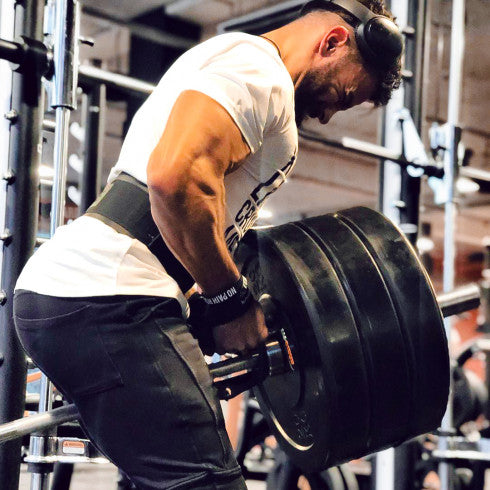 Training
TrainingSHOULD YOU USE A WEIGHT BELT FOR LIFTING?
The next person you see in the squat cage with 20 kg on the bar and a big belt, maybe you can make a comment after reading these few lines.
 Our Tips
Our TipsHow to train flexibility?
The way to train flexibility is often highly controversial. Depending on the sports you practice, you work differently. A dancer and an athlete tra...
 Dietary Supplements
Dietary SupplementsWhy take turmeric?
There are hundreds and hundreds of spices with different properties and turmeric is obviously one of them! It is a spice that is generally quite we...
Which fat burner to choose?
To lose weight and burn fat, there is no secret: you have to do sport and take care of your diet. However, it is possible to speed up the process t...
 Our Tips
Our TipsFasting and sport: 9 tips for training during Ramadan.
Working out during Ramadan is not easy. Not eating from sunrise to sunset is a major challenge for athletes wishing to continue their activities. T...
 Our Tips
Our TipsSummer holidays: How to limit the damage?
On holiday, we often tend to let ourselves go. Unless you're a hardcore sportsman, you tend to abandon your trainers and indulge in a lot of dietar...
 Health
HealthHow to preserve your joints?
We have a total of about 400 joints located throughout the body. We therefore quickly understand why joint problems are quite common. You don't hav...
 Our Tips
Our Tips9 good reasons to do sport.
Sometimes the urge to exercise is not always there. And although we always tell ourselves that this year will finally be the right one to get back ...
